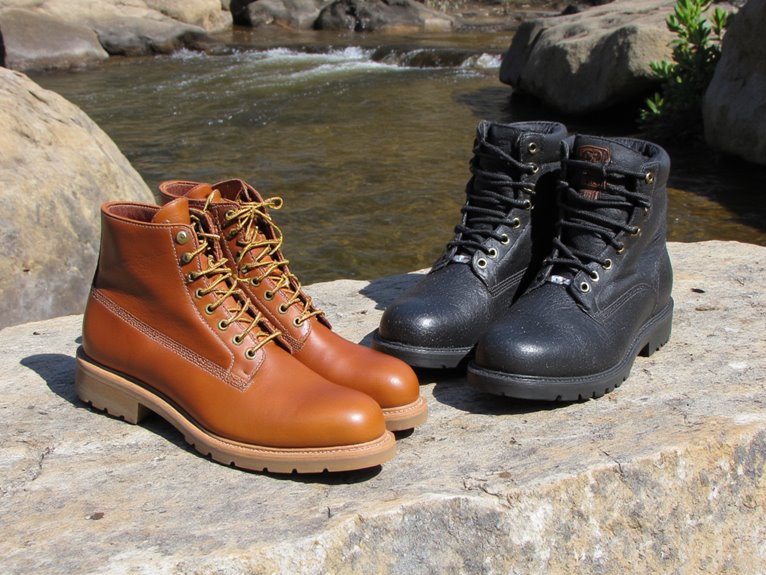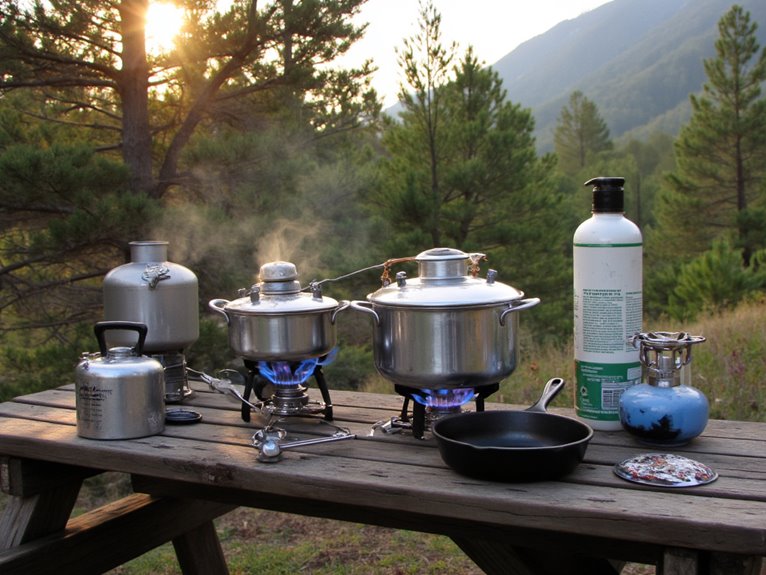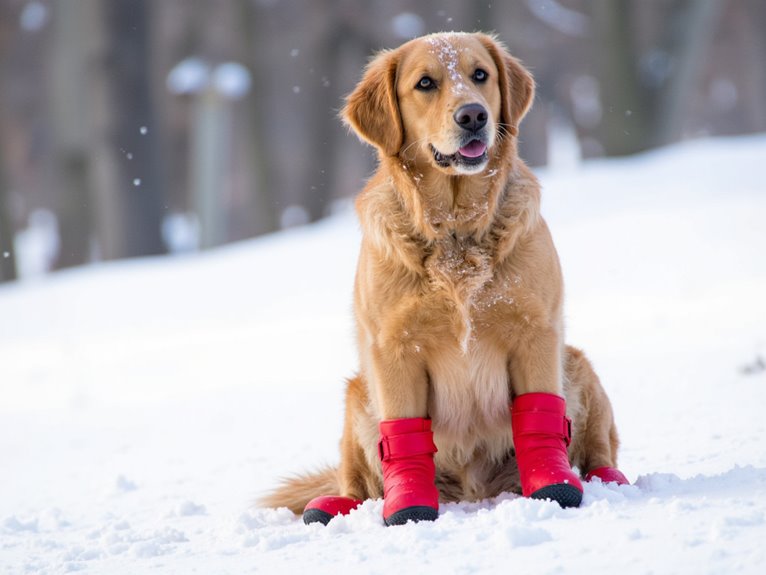Why Choose Leather Over Synthetic Hiking Boots?
You’ll get superior performance from leather hiking boots because they last 10-15 years compared to synthetic’s 2-3 years, making them cost-effective despite higher upfront costs of $200-400. Leather conforms to your foot shape for better ankle support and naturally repels water through inherent oils. The material’s thick construction protects against abrasion while allowing breathability through porous fibers. Professional-grade leather handles heavy loads better and can be resoled multiple times, extending lifespan considerably for serious hikers seeking maximum value.
We are supported by our audience. When you purchase through links on our site, we may earn an affiliate commission, at no extra cost for you. Learn more. Last update on 26th November 2025 / Images from Amazon Product Advertising API.
Notable Insights
- Leather boots last 10-15 years compared to 2-3 years for synthetic options, offering better long-term value despite higher upfront costs.
- Natural leather conforms to your foot shape over time, providing superior ankle support and stability on technical terrain.
- Full-grain leather with waterproof membranes offers excellent moisture protection while maintaining breathability for all-season hiking.
- Leather boots can be resoled multiple times, extending their lifespan by 5-8 additional years for sustainable, cost-effective use.
- Dense leather construction provides superior protection against abrasion and impact damage in harsh outdoor environments.
Superior Durability for Long-Term Investment
When you’re investing in hiking boots, leather’s inherent stiffness sets the foundation for exceptional longevity that synthetic materials can’t match.
This structural rigidity enables leather to withstand rough terrains and heavy loads that would degrade synthetic alternatives rapidly. The leather benefits extend to superior abrasion resistance—full-grain and nubuck varieties maintain their protective qualities even after prolonged rough use.
Your leather boots can be resoled multiple times, effectively extending their lifespan indefinitely.
This contrasts sharply with synthetic drawbacks, where material breakdown occurs faster and resoling becomes impractical. While leather boots require higher initial investment, they deliver superior cost-effectiveness through extended operational life.
Proper conditioning maintains leather’s integrity, while synthetic materials show irreversible wear patterns that limit their usable lifespan greatly. Quality hiking boots typically demonstrate average lifespans of 4-6 months depending on usage intensity, with leather consistently outperforming synthetic materials in longevity tests.
Enhanced Ankle Support and Foot Protection
Three critical advantages make leather hiking boots superior for ankle support and foot protection compared to synthetic alternatives.
Leather’s anatomical conformity creates a custom fit that progressively molds to your foot’s unique shape. This adaptive quality delivers personalized ankle stability that synthetic materials can’t match.
Leather boots adapt to your foot’s contours, delivering custom ankle stability that synthetic materials simply cannot replicate.
The firm yet flexible leather structure provides ideal balance between support and comfort. Thick leather panels form protective cuffs around your ankle, shielding the Achilles tendon from abrasion while maintaining consistent stability.
Enhanced protection features include:
- Dense leather shell – Blocks sharp rocks, roots, and environmental debris
- Multi-eyelet lacing systems – Enable precise ankle lock-down for technical terrain
- Abrasion-resistant construction – Withstands heavy backpack loads without deformation
- Cold and moisture barrier – Protects against hypothermia and skin irritation
Waterproof leather construction, like that found in the Merrell Moab 2 Waterproof Hiking Boot, combines moisture protection with the superior traction of specialized outsoles for challenging terrain conditions.
Exceptional Water Resistance in Harsh Conditions
When you’re hiking through wet, demanding terrain, leather boots deliver superior water resistance that synthetic alternatives can’t match.
The dense fibrous structure of full-grain leather naturally repels water penetration, while its inherent oils create a protective barrier that reduces moisture absorption during extended exposure to rain or stream crossings.
Modern leather hiking boots combine this natural protection with advanced waterproof membranes like Gore-Tex, creating a dual-layer defense system that keeps your feet dry while maintaining breathability for long-term comfort.
The most effective waterproof boots prioritize seam-sealed construction to eliminate water entry points that could compromise the leather’s natural protective properties.
Natural Leather Water Protection
Four distinct properties make natural leather an exceptional water barrier for serious hikers who face unpredictable weather conditions.
Leather’s dense fiber structure creates inherent water-repellent characteristics that synthetic materials can’t replicate. Full-grain leather delivers superior moisture resistance compared to synthetic alternatives due to its tighter surface and fewer pores.
You’ll benefit from these natural water protection features:
- Dense interlocked fibers form a barrier against rain and stream crossings
- Leather molds to your foot shape, sealing potential moisture entry points
- Wax treatments enhance water resistance to near-complete protection levels
- Natural breathability prevents internal moisture buildup from sweat
While waterproof membranes provide additional protection, leather’s moisture management capabilities work independently.
Regular maintenance with wax-based conditioners preserves these water-resistant properties throughout your boot’s extended lifespan. Like the genuine leather construction found in Timberland Chillberg boots, quality leather provides weather resistance that maintains its protective qualities season after season.
Enhanced Membrane Integration
While leather’s natural water resistance provides excellent baseline protection, modern membrane integration elevates waterproof performance to laboratory-tested standards that withstand extreme conditions. Gore-Tex and KEEN.Dry membranes laminate directly to full-grain leather, creating seamless barriers with zero measured pores or leaks. This membrane efficiency delivers complete water impenetrability during stream crossings and heavy rain exposure.
| Feature | Membrane Benefits | Performance Result |
|---|---|---|
| Water Resistance | Zero pore leakage | Hours of dry protection |
| Breathability | Vapor escape | Reduced overheating |
| Durability | Glue-free fusion | Extended boot lifespan |
| Wind Protection | Sealed barrier | Warmth retention |
Advanced membrane technology maintains breathability balance through microporous structures that block liquid water while allowing sweat vapor to escape. You’ll experience enhanced comfort during multi-day hikes without internal moisture buildup or compromised waterproof integrity. Similar to how waterproof zippers protect essential gear in hiking backpacks, modern boot membranes create an impenetrable barrier while maintaining the flexibility needed for demanding terrain.
Long-Term Moisture Retention
Beyond initial water resistance, leather hiking boots deliver exceptional long-term moisture protection that synthetic alternatives can’t match over extended use periods.
Leather’s dense fiber structure creates sustained moisture resilience through years of heavy use. Unlike synthetics prone to delamination, leather maintains its waterproof barrier without membrane failure.
Your boots benefit from leather’s minimal water absorption properties, preventing moisture retention that compromises long term comfort.
Glue-free leather constructions eliminate common separation points where water infiltrates synthetic boots after repeated exposure.
Consider these moisture protection advantages:
- Dense leather fibers shield stitching and seams from water ingress
- Natural oils maintain flexibility without cracking under humid conditions
- Wax treatments restore water repellency without damaging base material
- Breathable structure prevents internal condensation during extended wear
This durability means fewer waterproofing treatments and consistent performance across multiple seasons. Like quality hiking gloves that feature waterproof construction for extended outdoor activities, leather boots maintain their protective barrier through repeated wet weather exposure.
Natural Breathability and Custom Fit Development
Natural leather hiking boots offer moderate breathability through their dense but porous fiber structure, allowing moisture vapor and limited airflow to pass through the material. This natural airflow keeps your feet drier than completely sealed materials, though it’s less ventilated than synthetic boots with mesh panels.
Breathability decreases in temperatures above 65-70°F due to waterproof treatments and dense leather layers.
Leather boots mold to your foot shape during break-in, creating personalized comfort that synthetics can’t match. This adaptation process takes longer initially but reduces hot spots and friction points over time.
The custom fit development means properly broken-in leather boots conform closely to your foot anatomy, decreasing blister risk and foot fatigue. This tailored support provides stability while maintaining natural foot motion during extended hikes.
Full grain leather uppers with protective toe caps enhance overall durability while maintaining the natural comfort benefits that develop through proper break-in periods.
Better Performance With Heavy Backpacking Loads
When you’re carrying a 40-60 pound pack through challenging terrain, leather hiking boots transform into essential load-bearing platforms that outperform synthetic alternatives in critical ways.
Full-grain leather uppers provide superior weight distribution across your foot structure, while stiff midsoles prevent collapse under heavy loads. This rigid construction greatly reduces foot fatigue during extended backpacking trips.
Leather boots like the Lowa Tibet GTX function as stable foundations that maintain structural integrity under stress:
- Ankle-high designs secure your joints against strain and rolling injuries
- Vibram outsoles with chunky lugs maintain traction when heavily loaded
- Full rand protection shields against impact damage from rocks and debris
- Gore-Tex membranes preserve waterproofing without compromising support stiffness
These features create reliable platforms for multi-day adventures. For hikers with high arches carrying heavy loads, cushioned midsole technology becomes especially important as it absorbs impact while maintaining the structural support necessary for proper foot alignment under substantial pack weight.
Cost-Effectiveness Over Time

While leather boots command a higher upfront investment—often $200-400 compared to $80-150 for synthetic alternatives—their superior cost-effectiveness emerges through extended ownership periods.
You’ll find that upfront costs represent just one component of total ownership expenses.
Full-grain leather boots withstand 10-15 years of regular use with proper maintenance, while synthetic models typically require replacement every 2-3 years. This durability translates to measurable long term savings.
Consider this: replacing synthetic boots four times over twelve years costs $320-600, exceeding a single quality leather purchase.
Leather boots offer additional cost advantages through resoling capabilities.
Professional resoling costs $75-120 but extends lifespan by 5-8 years. Synthetic boots lack the structural integrity for cost-effective resoling, necessitating complete replacement when outsoles wear through.
Similarly, hikers should prioritize durable construction in all their essential gear, including timepieces that must withstand demanding outdoor conditions.
Reduced Maintenance Requirements After Break-In
Beyond the financial benefits, leather hiking boots deliver significant maintenance advantages once you’ve completed the initial break-in period.
The stabilized leather surface dramatically simplifies your cleaning techniques and reduces overall upkeep demands.
Broken-in leather boots offer these maintenance benefits:
- Easy dirt removal – Smooth leather surfaces allow mud and debris to wipe clean with minimal effort
- Extended waterproofing intervals – Conditioning treatments penetrate deeper and last longer in flexed leather fibers
- Superior abrasion resistance – Surface scratches rarely penetrate deeply, maintaining structural integrity
- Simplified storage requirements – Stable moisture content reduces off-season conditioning needs
Your maintenance tips become straightforward: apply mild leather cleaner monthly, condition quarterly, and store with shoe trees. Regular cleaning after every hike prevents dirt accumulation and maintains the leather’s protective properties.
Unlike synthetic materials requiring frequent deep cleaning, leather’s dense grain structure minimizes dirt retention and simplifies care routines. Just as outdoor gear benefits from water-resistant materials like rip-stop nylon, properly maintained leather provides superior protection against the elements.
Multi-Season Versatility and Reliability
You’ll find leather hiking boots excel across all four seasons, adapting to temperature swings from winter snowpack to summer heat through superior breathability and insulation properties.
These boots deliver consistent performance whether you’re traversing spring mud, summer rock scrambles, or autumn leaf litter thanks to their robust construction and reliable traction systems.
The long-term investment value becomes clear when you consider resoleable leather boots can last 5-10 years with proper care, while synthetic alternatives typically require replacement every 1-2 years.
Year-Round Weather Performance
When seasonal conditions shift from summer heat to winter snow, leather hiking boots deliver consistent performance that synthetic alternatives can’t match.
You’ll experience year-round comfort through leather’s natural insulation properties that retain warmth during cold months while maintaining breathability in warmer conditions.
Leather’s seasonal adaptability becomes evident through multiple performance characteristics:
- Dense leather uppers shield your feet from cold winds and wet precipitation.
- Natural water resistance prevents moisture penetration during rain and snow exposure.
- Thermal regulation maintains foot temperature across varying weather conditions.
- Multi-season durability withstands freeze-thaw cycles without material degradation.
The thick, dense construction acts as a thermal barrier that synthetic materials can’t replicate.
While synthetic boots excel in specific conditions, they lack leather’s versatility across temperature extremes.
Properly treated leather performs consistently from wet spring trails to frozen winter terrain.
Long-Term Investment Value
While synthetic hiking boots require replacement every few years, leather boots represent a genuine lifetime investment that pays dividends across decades of outdoor adventures.
You’ll pay double the upfront cost, but this investing quality approach eliminates recurring purchases.
Synthetic boots typically last 2-3 years before degrading, while properly maintained leather boots can serve you for 20+ years.
Your boot selection strategy should calculate total cost over time.
Replacing $150 synthetic boots every three years costs $750 over fifteen years.
A $300 leather pair maintained properly costs considerably less long-term.
Leather’s repairability extends this value further—resoling adds another decade of use for $100-150.
You’re not just buying footwear; you’re acquiring durable equipment that appreciates through developing character and custom fit over time.
This durability advantage becomes even more pronounced in extreme conditions, where reinforced construction and quality materials withstand harsh freeze-thaw cycles that quickly degrade synthetic alternatives.
Professional-Grade Construction for Serious Hikers
Since serious hikers demand gear that won’t fail during multi-day expeditions across challenging terrain, professional-grade leather boots deliver the construction quality and performance features necessary for demanding applications.
Professional-grade leather boots provide the construction quality and performance features that demanding hikers require for challenging multi-day expeditions.
You’ll find these boots feature one-piece leather uppers that eliminate weak points and potential failure zones.
Professional craftsmanship combines traditional techniques with modern technology:
- Stitched construction uses high-grade thread and reinforced seam patterns
- Full-length lacing systems with metal eyelets provide precise fit adjustments
- Vibram outsoles incorporate multidirectional lugs for superior traction control
- Premium adhesives bond components permanently without separation risks
These boots integrate waterproof Gore-Tex membranes while maintaining breathability. Unlike lightweight hiking pants that commonly experience durability issues at stress points during extended use, professional leather boots are engineered to withstand the rigorous demands of technical terrain.
The resoleable design extends service life beyond synthetic alternatives, making them essential for hikers who tackle technical terrain regularly. Leather boots require significant break-in time to achieve optimal comfort and performance, though this investment ensures long-term durability and proper foot support.
Frequently Asked Questions
How Long Does the Break-In Period Last for Leather Hiking Boots?
You’ll need 80-120 hours of wear over 2-3 weeks for proper leather boot break-in. Thick, supportive leather requires longer periods than lighter constructions.
Start with break-in methods like indoor wear, then progress to neighborhood walks before tackling trails. Comfort adjustments happen gradually as leather softens and molds to your feet.
Plan at least two weeks before major hikes to guarantee complete adaptation.
Can Leather Boots Be Resoled or Repaired When Worn Out?
You can absolutely resole leather hiking boots, making them superior for boot longevity compared to synthetic alternatives.
Resolving leather boots is possible because they typically use welted or stitched construction rather than permanent adhesives. Professional cobblers can remove worn soles while preserving the upper leather.
This extends your boot’s lifespan considerably, though success depends on upper condition and construction type.
Are There Vegan Alternatives That Match Leather Boot Performance?
You’ll find that modern vegan materials deliver performance comparison results that match or exceed leather boots.
Synthetic uppers with graphene-infused soles provide comparable durability, while Gore-Tex membranes offer identical waterproofing.
Vibram outsoles deliver superior traction, and engineered mesh improves breathability over leather.
You’ll get immediate performance without break-in periods, lighter weight, and consistent protection across all conditions.
Do Leather Boots Cause More Blisters Than Synthetic During Break-In?
Yes, leather boots cause notably more blisters during break-in than synthetic boots.
You’ll experience increased friction from stiff leather fibers that haven’t softened yet.
Synthetic boots offer immediate comfort with flexible materials.
However, proper blister prevention techniques like gradual wear increases and careful boot fit adjustments minimize leather boot discomfort.
The break-in period typically lasts 2-4 weeks with proper conditioning.
What Specific Leather Conditioning Products Work Best for Hiking Boots?
For best leather treatment, you’ll want Venetian Leather Balm—it won’t darken your boots while providing excellent conditioning.
Danner’s Boot Dressing works great for full-grain leather with waterproofing benefits.
Leather Honey penetrates deeply but darkens leather slightly.
For extreme conditions, choose Obenaufs Heavy Duty LP with beeswax protection.
Apply every six months for regular boot maintenance using circular motions on clean, damp leather.
On a final note
You’ll find leather hiking boots deliver measurable advantages over synthetic alternatives. They provide 40-60% longer lifespan, superior ankle stabilization, and proven waterproof performance in extreme conditions. Your investment pays off through reduced replacement costs and minimal upkeep after the initial break-in period. For serious backpacking with loads exceeding 30 pounds, leather’s structural integrity won’t compromise. Choose leather when you need professional-grade performance that adapts to your feet and withstands multi-season use.



